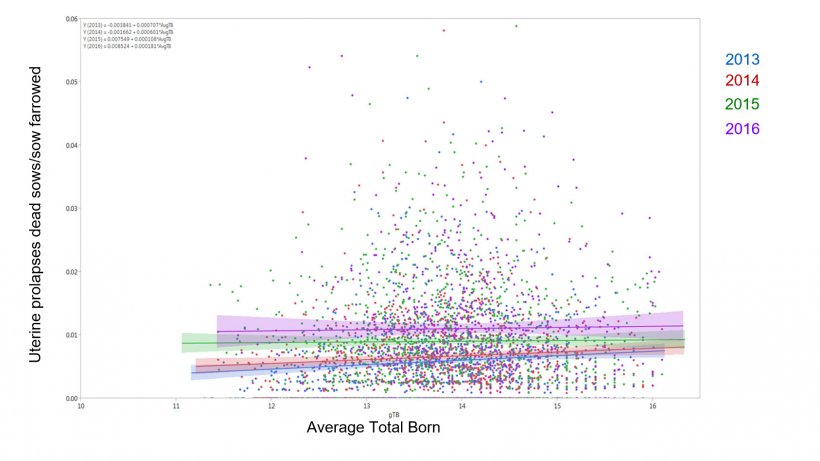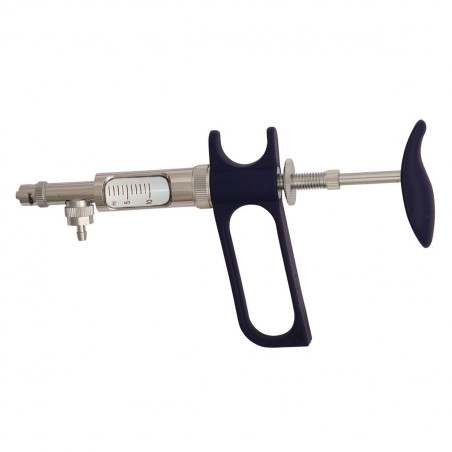Uterine prolapses are a rare event. Historically, prolapses rates have been estimated to be less than 1% of the total sows dead; however, producers have been experiencing a worrying increased of this type of prolapses over the last 6 years and this has been statistically demonstrated in Part I of this article. Although several causes have been speculated, the available literature is scarce and additional research is needed to further clarify the etiology. Some of the important management variables to consider include parity, total born, mycotoxins in feed, and assistance during farrowing among others. Furthermore, porcine epidemic diarrhea (PED) and porcine reproductive and respiratory syndrome (PRRS) are important diseases which clinical signs have been speculated to have an impact in the increase of sow prolapse incidence. Even though this trend initiated at the same time of the emergence of PED and severe strains of PRRS virus in the field, the relationship with the uterine sow prolapses remains still unknown. Therefore, the objectives of this study were to evaluate the role of management practices, and production parameters, as well as PRRS and PED disease status as covariates in the trend analysis of uterine sow prolapses.
As described in the first article, participant farms from 7 systems in North America were asked to share their retrospective monthly production data as well as some of their feeding and management practices (i.e parity, total born, toxic binder present, assistance during farrowing or “sleeving”, and sow feed intake during gestation and lactation). With regards of the disease status, farms were considered positive if any month had a positive within the year otherwise their status was considered negative or "Non applicable" if missing. In order to test for their importance as possible risk factors, multiple models were tested adding each of the variables one by one within the analysis explained in the first article.

Table1. Summary table of the covariates odds ratio (OR) for uterine prolapses in the sow investigation model.
| Variable tested | Result | OR (95 % CI) |
| Parity | Non significant | Non applicable |
| Total born | Significant | 1.03 - 1.11 |
| Toxin binder (N vs Y) | Significant | 0.78 - 0.96 |
| Assistance (N vs Y) | Significant | 1.02 - 2.25 |
| PED (neg. vs pos.) | Significant | 0.83 - 0.99 |
| PRRS (neg. vs pos.) | Non significant | 0.83 - 1.01 |
| Gestation intake | Non significant | Non applicable |
| Lactation intake | Non significant | Non applicable |
A total of 4,343,512 sow farrowing events from 153 farms in 2012 and 167 during the years of 2013 to 2016 were included in the study. Table 1 summarizes all the results. Just a few comments about the variables that were significantly associated with the presence of sow prolapses in our study across years:
1. Total born: The relationship between total born and rate of prolapses overtime is shown in the figure 1. The average total born was positively associated with the number of sow prolapses per total sows farrowed. As the average number of total born increases by 1, the odds of having a death sow due to prolapses increased between 3% and 11%. A possible cause could be an increase in the abdominal pressure, among others.

2. The use of toxin binder: The variable “toxin binder present” showed a positive and significant association with the increase in sow prolapses in the study. The rate of sow deaths with sow prolapses in farms without toxin binder compared to those with toxin binder were 5.95% and 6.87% respectively. A possible cause could be the presence of mycotoxin in the feed but this is just a speculation because the finding and evaluation of mycotoxin overtime in feed was out of the scope of this type of study.
3. Assistance during farrowing: Sow farms that were not assisting the sows during farrowing were more likely to have higher rates of sow prolapses. Estimated prolapse rates were 10.1 and 6.69 in farms that were not assisting compared to those assisting. A possible cause could be an increment in the abdominal pressure in sows with a problematic farrowing. However, we should highlight the number of sow farms that were not giving assistance at farrowing was very small, thus this result must be considered with caution.
4. PED health status: The presence of PEDV in the farm had a significant and positive association to sow prolapse per sows farrowed. Sows from PED negative farms were 1% to 20% less likely to have sow prolapses per farrow than those in PED positive farms. Severe causes of enteritis have been described as a cause of certain types of prolapses in sows, however these were out of the scope of this study.
5. PRRSV health status: Farms PRRSV positive were very close to have a significant association to sow deaths due to prolapse. As shown in Table 1, farms PRRSV negative are -1 to 20.5% less likely to have sow deaths due to prolapses per farrow than PRRSV positive ones.
Neither parity, nor intake levels in lactation or gestation intakes were significantly associated with our variable of interest.
As a summary, results from this exploratory study show an association to the covariates for the percentage of uterine prolapses deaths per sow farrowed. Due to the limitations of this voluntary study, we cannot conclude that these associations were the cause of the prolapses observed in the study. However, these relationships presented here are worth investigating further with additional industry representation. Understanding whether or not these risk factors have a cause and effect relationship to sow prolapse would be crucial to improve the economics and welfare of the sow farms.





